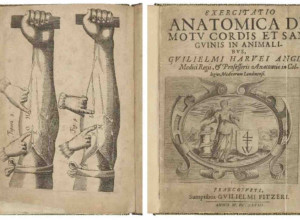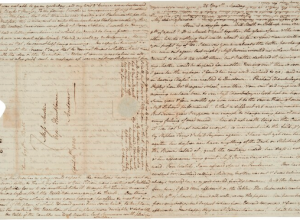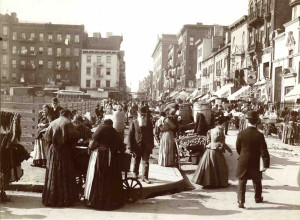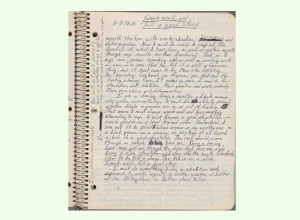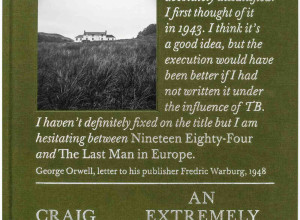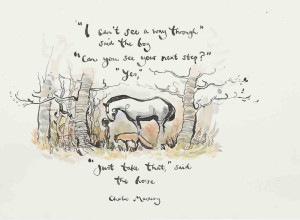Students at Southeastern University Work with Rare Books
For the first time, English students at Southeastern University (SEU) in Lakeland, Florida, have the opportunity to examine various editions and manuscripts while reading and analyzing John Milton's epic poem Paradise Lost by John Milton (1608-1694). English professor Cameron McNabb, happens to be a collector of rare and antiquarian manuscripts, and this semester has opened her personal Milton archives to students to provide fresh context and nuance to Milton's desire to "justify the ways of God to men."
Professor McNabb spoke with us recently about catching the collecting bug, why Milton has remained a formidable influence in her life and work, and what she hopes her students will learn from working with primary sources.
I understand Milton was your first love--discovered while you were an undergraduate English student at the University of Maryland. Could you talk about what you find so compelling about him and his work?
I actually first encountered Milton in high school. I read Paradise Lost "for fun" and I was hooked. I was already interested in Christian theology, but I had not encountered a writer who was willing to ask the tough questions like Milton was. He introduced me to questions I didn't even know I should be asking, and he did so in the most beautiful poetry I had ever read. He has been the most formative thinker and writer in my own life and faith.
What would you say is the highlight of your Milton collection?
My 1738 edition of Paradise Lost was my first purchase, and it is still the highlight to me, even though I now have older and rarer editions. I bought it from G. David's while studying one summer in Cambridge during grad school. My program provided tuition and accommodations, as well as breakfast and dinner, so I had only brought along enough money for several weeks' worth of lunches and a little spending money for the weekends. On my second or third day in Cambridge, I found G. David's and the 1738 edition. I bought it immediately, spending almost all of my summer's lunch money on it. I skipped lunches for the rest of the term, but Milton was definitely worth it.
Is this the first time students are working with rare books in your classes? If not, what has been student reaction to this kind of work?
This is the first time students are getting such a hands-on experience with my books. In previous classes, I've brought some items in and used them as examples of printing conventions or book history, and students have always been really drawn to looking at authentic examples. I find that what they're learning is much more meaningful to them when they can see real examples. Students this semester are very excited to get to work with so many items from my collection. For example, in some of our classes so far, I've handed out copies of engravings by Gustave Doré for us to discuss, but I remind them that they will be working with an actual edition of Doré's Paradise Lost as well!
What is the culminating activity for the class? What are the students expected to learn at the end of reading Paradise Lost?
 One of the things I stress with my students is that there are many ways to approach and respond to any text, and the way my Milton class is structured highlights that approach well. Over the course of the semester, we are analyzing not only the text of the poem but also visual representations of it (such as by Doré and William Blake), musical adaptions of it (such as Haydn's "The Creation"), and the textual and production histories of it (such as those found in my collection). Each of these approaches allows for students to explore the poem through a new lens. Students will be writing short essays on each of the facets I just mentioned, and then they will produce a final essay that combines all of these lenses and produces an original argument about the poem. In particular, there hasn't been much scholarly interest in the 18th-century editions of Milton, which my collection contains and which are part of the poem's tradition that extends to the visual and musical artists discussed, so I hope my students' analyses will begin to fill in a gap in the scholarship.
One of the things I stress with my students is that there are many ways to approach and respond to any text, and the way my Milton class is structured highlights that approach well. Over the course of the semester, we are analyzing not only the text of the poem but also visual representations of it (such as by Doré and William Blake), musical adaptions of it (such as Haydn's "The Creation"), and the textual and production histories of it (such as those found in my collection). Each of these approaches allows for students to explore the poem through a new lens. Students will be writing short essays on each of the facets I just mentioned, and then they will produce a final essay that combines all of these lenses and produces an original argument about the poem. In particular, there hasn't been much scholarly interest in the 18th-century editions of Milton, which my collection contains and which are part of the poem's tradition that extends to the visual and musical artists discussed, so I hope my students' analyses will begin to fill in a gap in the scholarship. Image: illustration by Gustave Doré, via Wikimedia Commons





